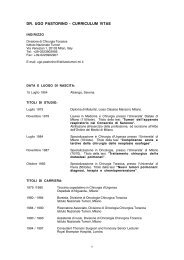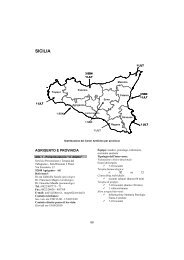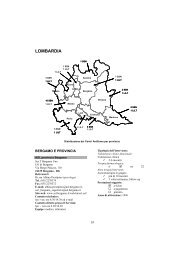Indoor particulate matter measurement as a tool in... - ARCHIVES ...
Indoor particulate matter measurement as a tool in... - ARCHIVES ...
Indoor particulate matter measurement as a tool in... - ARCHIVES ...
Create successful ePaper yourself
Turn your PDF publications into a flip-book with our unique Google optimized e-Paper software.
Monaldi Arch Chest Dis<br />
2004; 61: 3, 183-192 TOBACCO PUCH<br />
<strong>Indoor</strong> <strong>particulate</strong> <strong>matter</strong> <strong>me<strong>as</strong>urement</strong><br />
<strong>as</strong> a <strong>tool</strong> <strong>in</strong> the process of the<br />
implementation of Smoke-free Hospitals<br />
S. Nard<strong>in</strong>i 1, R. Cagn<strong>in</strong> 1, G. Invernizzi 2,3, A. Ruprecht 2,<br />
R. Boffi 2, S. Forment<strong>in</strong>i 1<br />
ABSTRACT: <strong>Indoor</strong> <strong>particulate</strong> <strong>matter</strong> <strong>me<strong>as</strong>urement</strong> <strong>as</strong> a<br />
<strong>tool</strong> <strong>in</strong> the process of the implementation of Smoke-free<br />
Hospitals. S. Nard<strong>in</strong>i, R. Cagn<strong>in</strong>, G. Invernizzi, A. Ruprecht,<br />
R. Boffi, S. Forment<strong>in</strong>i.<br />
Aim of the study: There are International and National<br />
standards that requires hospitals and health premises to<br />
be smoke-free. Accord<strong>in</strong>g to recent data from Italy and<br />
other European Countries, smok<strong>in</strong>g is a widespread habit<br />
<strong>in</strong> hospitals. To get smoke-free hospitals <strong>in</strong> an Italian region,<br />
we have adopted the European Code for smoke-free<br />
hospitals, which sets standards and provides <strong>in</strong>struments<br />
for its implementation. Accord<strong>in</strong>g to the Code, whenever<br />
possible, each step towards a smoke-free hospital, should<br />
be shared by all staff. As a mean for achiev<strong>in</strong>g this goal, <strong>in</strong><br />
our region the certification of s<strong>in</strong>gle units <strong>as</strong> smoke-free<br />
units h<strong>as</strong> been chosen. For gett<strong>in</strong>g the certification, besides<br />
implement<strong>in</strong>g the Code, we planned to use ETS (Environmental<br />
Tobacco Smoke) monitor<strong>in</strong>g, <strong>as</strong> ETS should not be<br />
present <strong>in</strong> hospitals. As a marker of ETS we have chosen<br />
Particulate Matter (PM), <strong>as</strong> it can e<strong>as</strong>ily be me<strong>as</strong>ured <strong>in</strong><br />
real-time with a portable <strong>in</strong>strument and, when other -<br />
even outdoor - sources of combustion can be ruled out, it<br />
is an accurate detector of cigarette smoke. Here the first<br />
experience of me<strong>as</strong>ur<strong>in</strong>g PM <strong>in</strong> hospitals for monitor<strong>in</strong>g<br />
ETS and certificat<strong>in</strong>g smoke-free health premises, is described.<br />
Materials and methods: PM <strong>me<strong>as</strong>urement</strong>s were carried<br />
out without any previous notification <strong>in</strong> different are<strong>as</strong><br />
of two Network hospitals of the Veneto Region, dur<strong>in</strong>g<br />
a s<strong>in</strong>gle work<strong>in</strong>g day. A real time l<strong>as</strong>er-operated aerosol<br />
Keywords: Tobacco smok<strong>in</strong>g, Environmental tobacco smoke, Health staff, Smoke-free hospitals, Particulate Matter.<br />
1 Pulmonary and TB Unit, Vittorio Veneto General Hospital, Italy; Veneto Region - 2004-2006 Regional Plan for the prevention<br />
of smok<strong>in</strong>g related dise<strong>as</strong>es.<br />
2 Tobacco Control Unit, National Cancer Institute, Milan.<br />
3 SIMG, Italian College of GPs, Milan.<br />
Correspondence: Stefano Nard<strong>in</strong>i, Pulmonary and TB Unit, Vittorio Veneto General Hospital, Viale Forlan<strong>in</strong>i, 71 - 31029<br />
Vittorio Veneto (TV) Italy; e-mail: snard<strong>in</strong>i@qubisoft.it.<br />
This study h<strong>as</strong> been partly f<strong>in</strong>anced with an unrestricted educational grant from AIMAR (Italian Scientific Society for the Study<br />
of Respiratory Dise<strong>as</strong>e).<br />
Introduction<br />
S<strong>in</strong>ce 1993, the World Health Organisation<br />
(WHO) def<strong>in</strong>ed health services <strong>as</strong> the central po<strong>in</strong>t<br />
<strong>in</strong> actions aimed at gett<strong>in</strong>g a smoke-free community<br />
[1] and accord<strong>in</strong>g to the Ottawa conference,<br />
hospitals should not only treat dise<strong>as</strong>es but also<br />
promote health [2].Tobacco smok<strong>in</strong>g – both active<br />
m<strong>as</strong>s analyser w<strong>as</strong> used. Several cl<strong>as</strong>ses of PM (PM1,<br />
PM2.5, PM7, PM10, TSP Total Suspended Particles) were<br />
me<strong>as</strong>ured.<br />
Results: Outdoor PM levels were found to be repeatedly<br />
lower than the annual official limits of 65 mcg/m3 and<br />
around the 24 hour official limits of 15 mcg/m3 [15 to 20<br />
mcg/m3, with an overall mean (±SD) of 17.8 (1.9)]<br />
throughout the whole day. Very good <strong>in</strong>door air quality<br />
w<strong>as</strong> found <strong>in</strong> the operat<strong>in</strong>g theaters and isolation department,<br />
where PM2.5 concentrations were much lower than<br />
outdoor levels [1.6 (0.9) and 5.9 (0.6) mcg/m3, respectively].<br />
No <strong>in</strong>cre<strong>as</strong>e <strong>in</strong> PM pollution w<strong>as</strong> found <strong>in</strong> the surveyed<br />
medical offices, halls and wait<strong>in</strong>g rooms where smok<strong>in</strong>g<br />
w<strong>as</strong> positively forbidden [PM2.5 concentrations of 14.8<br />
(2.2) and 12.9 (1.1) mcg/m3] except <strong>in</strong> a medical office and<br />
<strong>in</strong> two coffee rooms for staff only where high PM levels<br />
were recorded [PM2.5 58.7 (29.1), 27.0 (10.6) and 107.1<br />
(47.8) mcg/m3] and an offence of smok<strong>in</strong>g restrictions<br />
could be proved.<br />
Conclusions: The <strong>me<strong>as</strong>urement</strong> of PM <strong>in</strong> hospital for<br />
monitor<strong>in</strong>g ETS proved to be both fe<strong>as</strong>ible and sensible.<br />
PM <strong>me<strong>as</strong>urement</strong>s with a portable <strong>in</strong>strument can be used<br />
both for controll<strong>in</strong>g the compliance with rules or chosen<br />
standards and for educat<strong>in</strong>g staff about smok<strong>in</strong>g related<br />
hazards, thus ga<strong>in</strong><strong>in</strong>g consensus for the implementation of<br />
the tobacco control policy. In our experience, PM <strong>me<strong>as</strong>urement</strong><br />
can be used <strong>as</strong> an aid <strong>in</strong>side all actions designed<br />
by the European Code for smoke-free hospitals.<br />
Monaldi Arch Chest Dis 2004; 61: 3, 183-192.<br />
and p<strong>as</strong>sive – can be considered the most important<br />
cause of preventable death <strong>in</strong> developed<br />
Countries.<br />
But health promotion is not the only re<strong>as</strong>on<br />
why hospitals should be smoke-free. As any other<br />
workplace, hospitals should be smoke-free also for<br />
preserv<strong>in</strong>g the health of its workers, be he/she a<br />
non-smoker or smoker, by protect<strong>in</strong>g the former
from Environmental Tobacco Smoke (ETS) and by<br />
help<strong>in</strong>g the latter for smok<strong>in</strong>g cessation [3-4]. This<br />
does not seem to be the c<strong>as</strong>e at le<strong>as</strong>t <strong>in</strong> some countries<br />
<strong>in</strong> Europe where smok<strong>in</strong>g prevalence of<br />
health staff h<strong>as</strong> been surveyed: <strong>in</strong>deed, <strong>in</strong> many<br />
Countries <strong>in</strong> the World smok<strong>in</strong>g amongst health<br />
staff is a common enough habit [5, 6, 7] and smokers<br />
smoke <strong>in</strong>side hospitals, even if forbidden [5].<br />
To address this important po<strong>in</strong>t (<strong>in</strong>deed a crucial<br />
po<strong>in</strong>t <strong>in</strong> the fight aga<strong>in</strong>st tobacco related dise<strong>as</strong>es)<br />
<strong>in</strong> the l<strong>as</strong>t four years, two projects f<strong>in</strong>anced<br />
by the European Community have designed a<br />
complete programme to achieve smoke free hospitals<br />
and a European Network (European Network<br />
of Smoke-free Hospitals= ENSH) (Annex 1) h<strong>as</strong><br />
been launched. A “code” h<strong>as</strong> been produced (the<br />
European Code for Smoke- free Hospitals) to be<br />
used <strong>as</strong> a guidel<strong>in</strong>e and <strong>as</strong> a reference both for selfaudit<br />
and for external audit (table 1).<br />
Accord<strong>in</strong>g to the ENSH Self audit questionnaire,<br />
hospitals should comply with a certa<strong>in</strong> number<br />
of conditions required by the Network. Every<br />
item <strong>in</strong> the questionnaire, enters a score system<br />
that marks the steps toward a smoke- free environment,<br />
the full score def<strong>in</strong><strong>in</strong>g a hospital <strong>as</strong> a Smokefree<br />
Hospital.<br />
The code h<strong>as</strong> recently started to be implemented<br />
<strong>in</strong> an Italian region (Veneto) where the smok<strong>in</strong>g<br />
184<br />
Table 1. - The european code for smoke-free hospitals<br />
Commitment<br />
1. Engage decision-makers. Inform all personnel and patients.<br />
Communication<br />
2. Appo<strong>in</strong>t a work<strong>in</strong>g group. Develop a strategy and implementation<br />
plan.<br />
Education & Prevention<br />
3. Set up a tra<strong>in</strong><strong>in</strong>g plan to <strong>in</strong>struct all staff on how best to<br />
approach smokers.<br />
Identification & Cessation Support<br />
4. Organise cessation support facilities for patients and<br />
staff <strong>in</strong> the organisation and ensure cont<strong>in</strong>uity of support<br />
on discharge <strong>in</strong>to the community.<br />
Tobacco Control<br />
5. Indicate smok<strong>in</strong>g zones clearly, <strong>as</strong> long <strong>as</strong> they are considered<br />
necessary, keep<strong>in</strong>g them away from cl<strong>in</strong>ical and<br />
reception are<strong>as</strong>.<br />
Environment<br />
6. Adopt appropriate signage, <strong>in</strong>clud<strong>in</strong>g posters, signposts,<br />
etc. and remove all <strong>in</strong>centives to smoke (such <strong>as</strong><br />
<strong>as</strong>htrays, tobacco sales, etc.).<br />
Healthy Workplace<br />
7. Support systems are <strong>in</strong> place to protect and promote the<br />
health of all that work <strong>in</strong> the hospital.<br />
Review & Compliance<br />
8. Renew and broaden <strong>in</strong>formation to ma<strong>in</strong>ta<strong>in</strong> commitment<br />
to the policy.<br />
Monitor<strong>in</strong>g<br />
9. Ensure follow-up and quality <strong>as</strong>surance.<br />
Policy implementation<br />
10. First conv<strong>in</strong>ce, then constra<strong>in</strong> consider<strong>in</strong>g legislation<br />
if needed. Have patience!<br />
S. NARDINI ET AL.<br />
control is historically a little ahead than the National<br />
mean, <strong>as</strong> a part of a comprehensive programme<br />
of tobacco control.<br />
In the first ph<strong>as</strong>e, the current situation of<br />
smok<strong>in</strong>g control <strong>in</strong> hospitals and health districts<br />
h<strong>as</strong> been audited, by means of the ENSH self-audit<br />
questionnaire: The second ph<strong>as</strong>e, <strong>in</strong> the progressive<br />
path designed by ENSH with three levels<br />
of adherence to the Code (table 2) - is to improve<br />
all the actions for tobacco control, <strong>in</strong>volv<strong>in</strong>g all<br />
staff.<br />
In Veneto, a region situated <strong>in</strong> the north e<strong>as</strong>t of<br />
Italy, with 4.5 million <strong>in</strong>habitants, a work<strong>in</strong>g group<br />
(see Annex 1) is carry<strong>in</strong>g out the implementation<br />
process of the European code by recognis<strong>in</strong>g, <strong>in</strong><br />
each hospital, s<strong>in</strong>gle units or wards, <strong>as</strong> “smokefree”<br />
units and officially certify<strong>in</strong>g them (<strong>in</strong> a publicly<br />
visible way).<br />
This certification process will consist of two<br />
steps: 1. a self-audit; 2. an external audit, aimed at<br />
me<strong>as</strong>ur<strong>in</strong>g the exposition (if any) due to environmental<br />
tobacco. If levels of exposition not higher<br />
than outdoor air are detected, ETS can be ruled out<br />
and the certification given.<br />
PM <strong>me<strong>as</strong>urement</strong>s were chosen <strong>as</strong> a marker of<br />
ETS, because worries about PM <strong>in</strong>door pollution<br />
due to ETS are <strong>in</strong>cre<strong>as</strong><strong>in</strong>gly appreciated by lay<br />
people [8] and because recent technological advances<br />
have allowed the monitor<strong>in</strong>g of PM values<br />
<strong>in</strong> real time with the aid of portable and userfriendly<br />
<strong>in</strong>struments [9].<br />
As a prelim<strong>in</strong>ary experience, we wanted to<br />
verify the fe<strong>as</strong>ibility of the technique, and its <strong>in</strong>troduction<br />
<strong>as</strong> a criterion for certify<strong>in</strong>g a health<br />
premise <strong>as</strong> smoke- free.<br />
In each hospital we surveyed all are<strong>as</strong>, with<br />
special attention to the are<strong>as</strong> which <strong>in</strong> a<br />
previous survey on Italian Hospitals [10] were<br />
reported to be plagued by ETS: i.e. Kitchens<br />
(84.6%), Toilets (83.3%) and Wait<strong>in</strong>g rooms<br />
(70.9%).<br />
This paper reports the results of our first experience,<br />
carried out <strong>in</strong> two hospitals which jo<strong>in</strong>ed<br />
the network, which confirms the fe<strong>as</strong>ibility of such<br />
a control and its possible use for certification.<br />
To the best of our knowledge this is the first<br />
time that PM h<strong>as</strong> been me<strong>as</strong>ured <strong>in</strong> hospitals with<br />
the aim of detect<strong>in</strong>g ETS, so gett<strong>in</strong>g the elements<br />
for certification of a smoke-free health environment.<br />
Table 2. - Level of partecipation to the ensh<br />
Participation and registration with the European Network<br />
will be on three levels:<br />
Bronze<br />
Denotes commitment and endorsement of Codes 1 & 2.<br />
Silver<br />
Denotes achievement of the European M<strong>in</strong>imum Standard<br />
Policy.<br />
Gold<br />
Denote certified atta<strong>in</strong>ment of a Smoke-Free environment.
INDOOR PARTICULATE MATTER MEASUREMENT AS A TOOL IN THE PROCESS OF THE IMPLEMENTATION OF SMOKE-FREE HOSPITALS<br />
Methods<br />
PM <strong>me<strong>as</strong>urement</strong>s were carried out without a<br />
previous notice <strong>in</strong> halls, cl<strong>in</strong>ics, operat<strong>in</strong>g theaters,<br />
medical offices, wait<strong>in</strong>g rooms, kitchens, toilets and<br />
coffee rooms <strong>in</strong> departments of two Network hospitals<br />
of the Veneto Region, dur<strong>in</strong>g a work<strong>in</strong>g day. A<br />
l<strong>as</strong>er-operated aerosol m<strong>as</strong>s analyser w<strong>as</strong> used (Aerocet,<br />
Metone Instruments, Grant P<strong>as</strong>s, Oregon, US).<br />
The <strong>in</strong>strument calculates the concentration of several<br />
cl<strong>as</strong>ses of PM (PM1, PM2.5, PM7, PM10, TSP)<br />
by analys<strong>in</strong>g air samples every 2 m<strong>in</strong>utes. PM2.5<br />
w<strong>as</strong> chosen <strong>as</strong> representative of ETS pollution (see<br />
Discussion). by analys<strong>in</strong>g air samples every 2 m<strong>in</strong>utes.<br />
The <strong>in</strong>strument is precalibrated and validated<br />
by comparison with gravimetric EPA FRM (Federal<br />
Reference Method) and the equivalent accord<strong>in</strong>g to<br />
Italian Standard (see appendix). The analyser is<br />
pocket-sized, operates automatically with a battery<br />
autonomy for up to 8 hours; data are stored on the <strong>in</strong>ternal<br />
memory, can be visualized immediately on<br />
display and subsequently downloaded on a computer.<br />
All the data were collected on the same day, tak<strong>in</strong>g<br />
a time-table record of the different places with<br />
the <strong>in</strong>strument cont<strong>in</strong>uously work<strong>in</strong>g. The overall<br />
time of <strong>me<strong>as</strong>urement</strong> w<strong>as</strong> 10 hours. Technical details<br />
are described <strong>in</strong> the Appendix.<br />
Table 3. - Peak PM2.5 concentrations <strong>in</strong> different places monitored <strong>in</strong> two hospitals<br />
Results<br />
Particulate <strong>matter</strong> concentration recorded <strong>in</strong><br />
the different places of one hospital are shown <strong>in</strong><br />
table 3.<br />
Throughout the whole day outdoor PM2,5 levels<br />
were found repeatedly lower than the average<br />
annual official limits of 65 mcg/m3 and around the<br />
24 hour average limits of 15 mcg/m3, accord<strong>in</strong>g to<br />
the US EPA, with record<strong>in</strong>g rang<strong>in</strong>g between 15<br />
and 20 mcg/m3, and an overall mean (±SD) of<br />
17.8 (1.9) mcg/m3. Very good <strong>in</strong>door air quality<br />
w<strong>as</strong> found <strong>in</strong> the hospitals <strong>in</strong> are<strong>as</strong> where smok<strong>in</strong>g<br />
policy w<strong>as</strong> strictly complied with, and particularly<br />
<strong>in</strong> operat<strong>in</strong>g rooms and isolation departments,<br />
where mean PM2.5 concentrations were much<br />
lower than outdoor levels [(1.6 (0.9) and 5.9 (0.6)<br />
mcg/m3, respectively], reveal<strong>in</strong>g the efficiency of<br />
special air depuration systems <strong>in</strong>stalled to reduce<br />
viral and bacterial pollution.<br />
In addition, no <strong>in</strong>cre<strong>as</strong>e <strong>in</strong> PM pollution w<strong>as</strong><br />
found <strong>in</strong> medical offices, halls and wait<strong>in</strong>g rooms<br />
where smok<strong>in</strong>g w<strong>as</strong> positively forbidden, with<br />
PM2.5 concentrations of 14.8 (2.2) and 12.9 (1.1)<br />
mcg/m3 m3, respectively. In these are<strong>as</strong> PM values<br />
were similar to outdoor record<strong>in</strong>gs, an expected<br />
result <strong>in</strong> conf<strong>in</strong>ed ambient without additional<br />
Place Smok<strong>in</strong>g ban observed/respected PM2.5 <strong>in</strong>door* PM2.5 outdoor<br />
operat<strong>in</strong>g room yes 1.6 (0.9) 18.3 (1.2)<br />
isolation department yes 5.9 (0.6) 15.4 (1.8)<br />
wait<strong>in</strong>g room yes 12.9 (1.1) 20.0 (1.9)<br />
medical office 1 yes 14.8 (2.2) 15.4 (1.8)<br />
medical office 2 no 58.7 (29.1) 17.5 (3.3)<br />
coffee room 1 no 27.0 (10.6) 17.5 (3.3)<br />
coffee room 2 no 107.1 (47.8) 18.3 (1.2)<br />
*mcg/m 3 (SD), 30 m<strong>in</strong>utes average m<strong>in</strong>imum.<br />
Fig. 1. - Overall PM 2.5 dur<strong>in</strong>g a 10 hour cont<strong>in</strong>uous monitor<strong>in</strong>g <strong>in</strong> different places of one hospital.<br />
185
combustion sources, due to the rapid distribution<br />
of atmospheric PM <strong>in</strong>side build<strong>in</strong>gs. In the few<br />
places where smok<strong>in</strong>g restrictions were disregarded,<br />
PM levels were promptly <strong>in</strong>dividuated, <strong>as</strong><br />
shown by high pollution <strong>in</strong> a medical office and <strong>in</strong><br />
two coffee rooms [PM2.5 58.7 (29.1), 27.0 (10.6)<br />
and 107.1 (47.8) mcg/m3, respectively. Some<br />
sharp peaks were detected along the corridors dur<strong>in</strong>g<br />
the analyser transfer from one room to another<br />
probably due to smok<strong>in</strong>g visitors although no<br />
smokers have been noticed. The graphic representation<br />
of the overall cont<strong>in</strong>uous record<strong>in</strong>gs is<br />
shown <strong>in</strong> figure 1: the different places are shown at<br />
the different times on the l<strong>in</strong>es for PM2.5, with the<br />
mean PM2.5 outdoor concentration <strong>in</strong>dicated <strong>as</strong> a<br />
reference.<br />
186<br />
Discussion<br />
As emph<strong>as</strong>ised <strong>in</strong> the <strong>in</strong>troduction, due to their<br />
recognized role <strong>as</strong> centres for promot<strong>in</strong>g health,<br />
hospitals have the privilege of positively <strong>in</strong>fluenc<strong>in</strong>g<br />
tobacco control. However, recent surveys<br />
about smok<strong>in</strong>g habits <strong>in</strong> lead<strong>in</strong>g hospitals <strong>in</strong> Italy<br />
revealed a high percentage of smokers among hospital<br />
staff, along with a high prevalence of exposure<br />
to p<strong>as</strong>sive smok<strong>in</strong>g. In a previous study carried<br />
out <strong>in</strong> Italy [10], health staff did not significantly<br />
differ from the general population with respect<br />
to smok<strong>in</strong>g attitudes and the knowledge of<br />
smok<strong>in</strong>g related issues. Moreover, the same study<br />
showed that <strong>in</strong> female gender, the prevalence of<br />
smokers among health staff is higher than among<br />
the general population when matched for age<br />
group and educational level while, among males,<br />
the prevalence is roughly the same [10].<br />
S. NARDINI ET AL.<br />
In their study Zanetti and co-workers [11] observed<br />
a rate of personnel report<strong>in</strong>g exposure to<br />
p<strong>as</strong>sive smok<strong>in</strong>g of 88% <strong>in</strong>side the hospital especially<br />
<strong>in</strong> cook<strong>in</strong>g are<strong>as</strong>, at <strong>in</strong>formation desks and <strong>in</strong><br />
corridors despite exist<strong>in</strong>g smok<strong>in</strong>g bans <strong>in</strong> place.<br />
Another survey conducted among hospital pulmonary<br />
physicians conducted by one of us, revealed<br />
[12] also the need for <strong>in</strong>formation about <strong>in</strong>door<br />
pollution by tobacco smok<strong>in</strong>g. In conclusion,<br />
even if <strong>in</strong> Italy there have been laws forbidd<strong>in</strong>g<br />
smok<strong>in</strong>g <strong>in</strong>side health premises s<strong>in</strong>ce 1975, smok<strong>in</strong>g<br />
can be considered a widespread habit. Some<br />
33.3% of all staff are smokers (males 30.8% and<br />
females 34.9%) with a mean number of cigarettes<br />
smoked per day of 13.9 (S.D. 8.9) [12]. Accord<strong>in</strong>g<br />
to health staff, smokers smoke while on duty:<br />
some 80% of low nicot<strong>in</strong>e dependent smokers and<br />
more than 90% of highly dependent smokers report<br />
smok<strong>in</strong>g <strong>in</strong>side hospitals [10].<br />
Hospitals and health districts have a lead<strong>in</strong>g<br />
role and responsibility not only <strong>in</strong> spread<strong>in</strong>g educational<br />
messages on tobacco but also <strong>in</strong> show<strong>in</strong>g<br />
a tight compliance with them [13]. The educational<br />
value of smok<strong>in</strong>g policy me<strong>as</strong>ures is emph<strong>as</strong>ised<br />
by its implementation <strong>in</strong> health agencies. Such a<br />
critical role is emph<strong>as</strong>ized by the daily m<strong>as</strong>sive<br />
number of <strong>in</strong>-hospital contacts with citizens of all<br />
ages and different social status. However, for the<br />
re<strong>as</strong>ons already recorded, the compliance with National<br />
and International standards of smok<strong>in</strong>g control<br />
<strong>in</strong> hospitals is very difficult and, so far, nearly<br />
impossible. It is a problem not only <strong>in</strong> Italy. Recent<br />
surveys have also demonstrated a high prevalence<br />
of smokers <strong>in</strong> hospital staff throughout Europe<br />
[14]. In summary, while smoke- free hospitals (and<br />
smoke-free health premises) are absolutely neces-<br />
Table 4. - Results of the first Ensh self-audit questionnaire <strong>in</strong> the Veneto Region (Note: The characters of each<br />
health district are hidden under a PIN, known only to the central level and to the self-surveyed District. The red l<strong>in</strong>es<br />
show the two SD).
INDOOR PARTICULATE MATTER MEASUREMENT AS A TOOL IN THE PROCESS OF THE IMPLEMENTATION OF SMOKE-FREE HOSPITALS<br />
sary (because they are workplaces <strong>as</strong> well <strong>as</strong><br />
places where health is promoted), the process of<br />
implementation is very difficult and far from<br />
achiev<strong>in</strong>g its goal. The European Code for smokefree<br />
hospitals h<strong>as</strong> been designed to help the implementation<br />
process.<br />
In Italy, where actions have already been carried<br />
out to atta<strong>in</strong> smoke- free hospitals [15] <strong>in</strong> the<br />
year 2002, the European Code started to be implemented<br />
<strong>in</strong> the Veneto region <strong>as</strong> a part of a comprehensive<br />
programme of tobacco control designed<br />
accord<strong>in</strong>g to the Surgeon General Standards [16].<br />
The first step consisted of an audit on the current<br />
situation of smok<strong>in</strong>g control <strong>in</strong> hospitals and<br />
health districts us<strong>in</strong>g the ENSH self-audit questionnaire.<br />
The results of this first survey (table 4)<br />
showed a patchy pattern with different situations<br />
<strong>in</strong> different health districts, and overall demonstrated<br />
that health premises are not smoke-free.<br />
The second step, along the ENSH implementation<br />
model, w<strong>as</strong> to <strong>in</strong>volve staff <strong>in</strong> tobacco control<br />
<strong>in</strong> a progressive way. So the Veneto group decided<br />
to firstly acknowledge s<strong>in</strong>gle units or wards, <strong>as</strong><br />
“smoke- free” units, by officially certify<strong>in</strong>g them<br />
<strong>in</strong> each hospital. This certification process should<br />
<strong>in</strong>clude a “visit” made by external staff (provided<br />
by the Regional work<strong>in</strong>g group) without previous<br />
notice, aimed at me<strong>as</strong>ur<strong>in</strong>g the exposition due to<br />
environmental tobacco smoke. If this visit detects<br />
levels of exposition under the threshold established<br />
by the exist<strong>in</strong>g laws, ETS is <strong>as</strong>sumed to be<br />
absent and the certification given for a set period<br />
of time.<br />
A smoke- free environment (i.e. an environment<br />
where no ETS can be detected) can be evaluated<br />
by me<strong>as</strong>ures of <strong>in</strong>dividual exposure like<br />
ur<strong>in</strong>e or saliva cot<strong>in</strong><strong>in</strong>e levels <strong>in</strong> non smokers [17],<br />
or by environmental me<strong>as</strong>ures of tobacco smoke<br />
pollutants like nicot<strong>in</strong>e [18], carbon monoxide<br />
[19] or PM [18, 19].<br />
A number of pros and cons characterise each<br />
of these different me<strong>as</strong>ures <strong>in</strong> terms of specificity,<br />
sensitivity, read<strong>in</strong>ess of response, potential <strong>in</strong>fluence<br />
on the general public (awareness of hazards<br />
which can expla<strong>in</strong> higher or lower levels of effectiveness),<br />
and time and resource costs (table 5).<br />
In this grad<strong>in</strong>g, cot<strong>in</strong><strong>in</strong>e is expensive, <strong>in</strong>direct,<br />
low-impressive but quite specific and sensitive;<br />
nicot<strong>in</strong>e is very specific and sensitive, but expensive,<br />
low-impressive and <strong>in</strong>direct; carbon monox-<br />
Table 5. - Comparison among diffent <strong>in</strong>dicators of<br />
environmental tobacco smoke.<br />
ide h<strong>as</strong> both low specificity and sensitivity, but is<br />
direct, impressive and quite cheap; f<strong>in</strong>ally, PM<br />
<strong>me<strong>as</strong>urement</strong> is considered of low specificity but<br />
endowed with high sensitivity, direct, impressive<br />
and quite <strong>in</strong>expensive.<br />
We decided to utilise PM <strong>me<strong>as</strong>urement</strong>s <strong>as</strong> the<br />
objective parameter of clean air for accreditation<br />
of Smoke - free Units <strong>in</strong> the Smoke - free Hospital<br />
Network, because b<strong>as</strong>ic <strong>in</strong>formation exists on PM<br />
<strong>as</strong> a dangerous pollutant and worries about PM <strong>in</strong>door<br />
pollution are widely appreciated by lay people.<br />
Moreover, <strong>in</strong>door levels can be compared to<br />
well known outdoor limits, and recent technological<br />
advances allow for the monitor<strong>in</strong>g of PM values<br />
<strong>in</strong> real time with the aid of portable and friendly-user<br />
<strong>in</strong>struments. PM2.5 w<strong>as</strong> chosen <strong>as</strong> tobacco<br />
smoke <strong>in</strong>dicator because the PM part of the tobacco<br />
smoke is composed mostly by particles sized<br />
less than 2.5 µm <strong>in</strong> diameter.<br />
In addition, s<strong>in</strong>ce PM2.5 particles have a very<br />
long deposition time, and distribute rapidly <strong>in</strong>to<br />
the whole ambient because of the <strong>in</strong>fluence of air<br />
turbulence, are therefore more representative of<br />
the real <strong>in</strong>door ETS pollution.<br />
F<strong>in</strong>ally, PM <strong>me<strong>as</strong>urement</strong>s imply neither an<br />
active collaboration by the staff <strong>in</strong>volved <strong>in</strong> the<br />
survey nor the <strong>as</strong>k<strong>in</strong>g for personal organic samples,<br />
which can be annoy<strong>in</strong>g.<br />
As for the PM <strong>me<strong>as</strong>urement</strong>s we carried out, our<br />
experience showed very good air quality <strong>in</strong> the surveyed<br />
are<strong>as</strong> of both hospitals. As expected, isolation<br />
departments and the operat<strong>in</strong>g theaters showed the<br />
lowest concentration of PM, while a fairly good <strong>in</strong>door<br />
air quality w<strong>as</strong> found <strong>in</strong> medical offices and<br />
wait<strong>in</strong>g rooms where smok<strong>in</strong>g bans were respected,<br />
with PM levels lower than outdoors’. In one hospital,<br />
where the survey w<strong>as</strong> more detailed, three are<strong>as</strong><br />
were detected where ETS w<strong>as</strong> present, produced by<br />
active smok<strong>in</strong>g <strong>in</strong>side Hospital, notwithstand<strong>in</strong>g exist<strong>in</strong>g<br />
smok<strong>in</strong>g ban. One of these places w<strong>as</strong> <strong>in</strong>deed<br />
a medical office that showed PM.<br />
Concentrations of about a 3 fold 24 hour average<br />
limits were found <strong>in</strong>side a medical office where<br />
smok<strong>in</strong>g ban w<strong>as</strong> not observed, while the highest<br />
pollution w<strong>as</strong> found <strong>in</strong> coffee room 2, with PM2.5<br />
reach<strong>in</strong>g concentrations 5 fold 24 hour average outdoor<br />
limits. So, PM <strong>me<strong>as</strong>urement</strong>s led to an objective<br />
me<strong>as</strong>ure of ETS and to a patent demonstration<br />
of failed compliance with exist<strong>in</strong>g rules.<br />
In the context of the implementation process<br />
towards smoke-free hospitals, accord<strong>in</strong>g to the<br />
standards set by the European Code of Smokefree<br />
Hospital, these f<strong>in</strong>d<strong>in</strong>gs will be used both for<br />
provid<strong>in</strong>g evidence of violations and for educat<strong>in</strong>g<br />
staff to health and <strong>in</strong>cre<strong>as</strong><strong>in</strong>g their commitment to<br />
a smoke- free hospital. Which one of these possible<br />
uses will be more emph<strong>as</strong>ised, will depend on<br />
the local situation.<br />
Our prelim<strong>in</strong>ary observations suggest that PM<br />
<strong>me<strong>as</strong>urement</strong> can be a practical, reproducible and<br />
economical <strong>tool</strong> to the aim of a smoke- free hospital.<br />
In fact many hospital facilities can be monitored<br />
<strong>in</strong> a few hours, and if necessary, the results<br />
can be discussed on the spot with hospital staff and<br />
officers to dissem<strong>in</strong>ate the commitment to air qual-<br />
187
ity control <strong>as</strong> a way to implement tobacco control.<br />
Atmospheric PM pollution is a good reference.<br />
For the process of accreditation we are plann<strong>in</strong>g an<br />
operational protocol requir<strong>in</strong>g a number of PM<br />
<strong>me<strong>as</strong>urement</strong>s <strong>in</strong> standard facilities (medical offices,<br />
operat<strong>in</strong>g rooms, wait<strong>in</strong>g rooms, cook<strong>in</strong>g are<strong>as</strong>,<br />
<strong>in</strong>formation desks) with a result<strong>in</strong>g m<strong>in</strong>imum<br />
score, which will be added to the score of the self<br />
audit questionnaires.<br />
In conclusion, on the b<strong>as</strong>is of our first experiences,<br />
we th<strong>in</strong>k that a model comb<strong>in</strong><strong>in</strong>g either the<br />
audit<strong>in</strong>g process accord<strong>in</strong>g to the ENSH code or repeated<br />
objective samples of ETS through PM <strong>as</strong> a<br />
me<strong>as</strong>ure of the compliance with the standards of EN-<br />
SH can be the key to achieve smoke-free hospitals.<br />
188<br />
References<br />
1. World Health Organisation. No tobacco day, 1993. Tobacco<br />
Alert, May, 1993.<br />
2. World Health Organisation. The Ottawa Charter for<br />
health promotion. Italian Translation <strong>in</strong>: Salute e territorio,<br />
1989 (64/65): 14-17.<br />
3. World Health Organisation (Europe). Tobacco free <strong>in</strong>itiative.<br />
Why smok<strong>in</strong>g <strong>in</strong> the workplace <strong>matter</strong>s: an employer’s<br />
guide. WHO - Europe Copenhagen, 2002.<br />
4. U.S Dept. Of Health and Human Services. Centers for<br />
dise<strong>as</strong>e control and prevention. Office on Smok<strong>in</strong>g and<br />
health. Wellness Council of American / American Cancer<br />
Society. Mak<strong>in</strong>g your workplace smoke-free: a decision<br />
maker’s guide. U.S Dept. Of health and Human<br />
Services. Centers for dise<strong>as</strong>e control and prevention.<br />
Office on Smok<strong>in</strong>g and health, 2000.<br />
5. Nard<strong>in</strong>i S, Bertoletti R, R<strong>as</strong>telli V, Ravelli L, Donner<br />
CF. Personal smok<strong>in</strong>g habit and attitude toward smok<strong>in</strong>g<br />
among the health staff of a general hospital. Monaldi<br />
Arch Chest Dis 1998; 53: 74-78.<br />
6. Li HZ, Rosenblod L. Ch<strong>in</strong>ese physicians’ cigarette<br />
smok<strong>in</strong>g habits and their anti-smok<strong>in</strong>g counsell<strong>in</strong>g practice.<br />
Health Promotion International 1996; 11: 89-94.<br />
7. Willa<strong>in</strong>g, I, Ladelund, S. Smok<strong>in</strong>g behaviour among<br />
APPENDIX<br />
ANALYSER AND CALIBRATION<br />
METHODS DESCRIPTION<br />
1. ANALYSER DESCRIPTION<br />
The Aerosol M<strong>as</strong>s Particulate Monitor Model<br />
AEROCET 531, produced by Metone Instruments<br />
Inc. of Grants P<strong>as</strong>s (Oregon, USA), a hand held<br />
analyser, provides a low cost and real time way to<br />
monitor particle size and concentration.<br />
The pr<strong>in</strong>ciple of operation is b<strong>as</strong>ed on the detection<br />
of the scatter<strong>in</strong>g light <strong>in</strong>duced by the <strong>particulate</strong><br />
when p<strong>as</strong>s<strong>in</strong>g through a l<strong>as</strong>er beam.<br />
The detectors system detects the light pulses<br />
and <strong>in</strong>tensities which correspond to the number<br />
and size respectively of the different particle<br />
which are cl<strong>as</strong>sified <strong>in</strong> the cl<strong>as</strong>sic TSP, PM 10, PM 7,<br />
PM 2,5, e PM 1 cl<strong>as</strong>ses. To the detected signal, correspond<strong>in</strong>g<br />
to said cl<strong>as</strong>ses, an empirical algorithm<br />
is applied to calculate the correspond<strong>in</strong>g weights<br />
and the data is presented on the display <strong>in</strong> mg/m3.<br />
S. NARDINI ET AL.<br />
hospital staff still <strong>in</strong>fluences counsell<strong>in</strong>g on smok<strong>in</strong>g.<br />
Nicot<strong>in</strong>e and Tobacco Research.<br />
8. Repace JL, Lowrey AH. <strong>Indoor</strong> air pollution, tobacco<br />
smoke and public health. Science 1980; 208: 464-69.<br />
9. Invernizzi G, Ruprecht A, Mazza R, Paredi P, Boffi R.<br />
Real-time <strong>me<strong>as</strong>urement</strong> of <strong>in</strong>door <strong>particulate</strong> <strong>matter</strong><br />
orig<strong>in</strong>at<strong>in</strong>g from environmental tobacco smoke: a pilot<br />
study. Epidemiol Prev 2002; 26: 30-34.<br />
10. Nard<strong>in</strong>i S, Carrozzi L, Bertoletti R, Matteelli G, Sabato<br />
E, Del Donno M. The AIPO target project “No smok<strong>in</strong>g<br />
hospitals”: descriptive results of the first epidemiological<br />
ph<strong>as</strong>e. R<strong>as</strong>s Patol App Resp 2001; 16: 261-272.<br />
11. Zanetti F, Gambi A, Bergam<strong>as</strong>chi A, Gentil<strong>in</strong>i F, De Luca<br />
G, Monti C, Stampi S. Smok<strong>in</strong>g habits, exposure to<br />
p<strong>as</strong>sive smok<strong>in</strong>g and attitudes to a non-smok<strong>in</strong>g policy<br />
among hospital staff. Public Health 1998; 112: 57-62.<br />
12. Nard<strong>in</strong>i S, Bertoletti R, R<strong>as</strong>telli V, Donner CF. The <strong>in</strong>fluence<br />
of personal tobacco smok<strong>in</strong>g on the cl<strong>in</strong>ical<br />
practice of Italian chest physicians. Eur Respir J 1998;<br />
12: 1450-3.<br />
13. Tillgren P, Jansson M, Höijer Y, Ullén H. Ma<strong>in</strong>ta<strong>in</strong><strong>in</strong>g<br />
a smoke-free policy: an observational and <strong>in</strong>terview<br />
study at a university hospital <strong>in</strong> Sweden. Eur J Cancer<br />
Prev 1998 Oct; 7 (5): 403-8.<br />
14. Dautzenberg, B. A survey of smok<strong>in</strong>g prevalence<br />
among heatlh staff <strong>in</strong> Europe. Hels<strong>in</strong>ki, World Conference<br />
on Tobacco or health.<br />
15. Nard<strong>in</strong>i S, Carrozzi L, Bertoletti R, Donner CF. The<br />
AIPO target project for smoke-free hospitals - 1997.<br />
R<strong>as</strong>s Patol App Resp 1998; 13: 201-205.<br />
16. U.S. Public health Service - Dept of Health and Human<br />
Services. Reduc<strong>in</strong>g tobacco use- A report of the Surgeon<br />
General - Executive Summary. Atlanta (GEO) 2000.<br />
17. Benowitz N. Cot<strong>in</strong><strong>in</strong>e <strong>as</strong> a biomarker of environmental<br />
tobacco smoke exposure. Epidemiologic Reviews 1996;<br />
18: 188-204.<br />
18. Wakefield MA, Chaloupka FJ, Kaufman NJ, Orleans<br />
CT, Barker DC, Ruel EE. Effect of restrictions on smok<strong>in</strong>g<br />
at home, at school, and <strong>in</strong> public places on teenage<br />
smok<strong>in</strong>g: cross sectional study. BMJ 2000; 321: 333-7.<br />
19. Klepeis NE, Ott WR, Repace JL. The effect of cigar<br />
smok<strong>in</strong>g on <strong>in</strong>door levels of carbon monoxide and particles.<br />
J Expo Anal Environ Epidemiol 1999; 9: 622.<br />
The analyser is designed to supply the data<br />
relative to the quality of the air <strong>in</strong> just 2 m<strong>in</strong>utes.<br />
After calibration us<strong>in</strong>g a reference gravimetric<br />
system (FRM), the <strong>in</strong>strument can be used to<br />
supply low cost, real time and reliable <strong>me<strong>as</strong>urement</strong>s<br />
of PM concentrations specially when it is<br />
necessary to detect and evaluate the presence of<br />
peaks.<br />
The AEROCET 531 is constituted by a sensor,<br />
a l<strong>as</strong>er diode, a rechargeable NiCd battery pack, a<br />
pump, an isok<strong>in</strong>etic probe, a microprocessor, a<br />
LCD display, the <strong>in</strong>terface for PC’s, a battery<br />
charger and accessories <strong>in</strong>cluded <strong>in</strong> a carry<strong>in</strong>g c<strong>as</strong>e.<br />
OPERATION: push<strong>in</strong>g the<br />
pump start and the sample is p<strong>as</strong>sed through the<br />
sensor chamber where the particle number and<br />
size are me<strong>as</strong>ured for 2 m<strong>in</strong>utes, then the algorithm<br />
applies to calculate the 2 m<strong>in</strong>utes average<br />
m<strong>as</strong>s concentration, memorize it and presents it<br />
on the display <strong>in</strong> the TSP, PM 10, PM 7, PM 2,5, e<br />
PM 1 cl<strong>as</strong>ses.<br />
Programm<strong>in</strong>g of the AEROCET: 531 it is possible,<br />
us<strong>in</strong>g one lap top PC with the dedicated soft-
INDOOR PARTICULATE MATTER MEASUREMENT AS A TOOL IN THE PROCESS OF THE IMPLEMENTATION OF SMOKE-FREE HOSPITALS<br />
ware, to download the memorised data and transfer<br />
it to Excel for successive elaborations.<br />
The AEROCET 531 can be equipped with a<br />
temperature and relative humidity sensor.<br />
As any other optical system, the AEROCET<br />
531 is RH sensitive but there is no theoretical compensation<br />
for error correction. It is therefore recommended<br />
not to use the <strong>in</strong>strument when the RH<br />
exceed 60-65%. However the follow<strong>in</strong>g empirical<br />
table can be used not to elim<strong>in</strong>ate the error but to<br />
m<strong>in</strong>imize it.<br />
% K multipl.<br />
Relative Humidity factor<br />
40 1<br />
45 1<br />
50 1<br />
55 0.96<br />
60 0.91<br />
65 0.85<br />
70 0.77<br />
75 0.67<br />
80 0.56<br />
85 0.45<br />
90 0.33<br />
95 Na<br />
1.1. Calibration<br />
The sensor is factory calibrated us<strong>in</strong>g PLS<br />
(polystirene latex) NIST traceable calibration particles.<br />
The use of PLS is actually the most accurate<br />
system for the calibration of particle counters. The<br />
particle count<strong>in</strong>g of the different sizes particles<br />
made by the AEROCET 531 is converted <strong>in</strong>to<br />
m<strong>as</strong>s us<strong>in</strong>g the algorithm hav<strong>in</strong>g a default factor of<br />
1.000 b<strong>as</strong>ed on the ARD (Arizona Road Dust)<br />
s<strong>in</strong>ce this ARD is <strong>as</strong>sumed to have a particle size<br />
distribution and weight the most similar to most<br />
common aerosols.<br />
However if the aerosol to be me<strong>as</strong>ured h<strong>as</strong> a<br />
different size or m<strong>as</strong>s distribution than the ARD,<br />
or the sample conditions such <strong>as</strong> temperature or<br />
humidity are different, there will be an error <strong>in</strong> the<br />
m<strong>as</strong>s <strong>me<strong>as</strong>urement</strong>. This error can be compensated:<br />
the algorithm <strong>in</strong>cludes 4 coefficients relatives<br />
to the particles sizes (p1, p2, p3 e p4 correspond<strong>in</strong>g<br />
to the cl<strong>as</strong>ses PM 10, PM 7, PM 2,5 e PM 1 respectively)<br />
and one more k1 for all sizes. (TSP)<br />
The default values of these coefficients<br />
(p1,p2,p3,p4 e k1) are 1.000, correspond<strong>in</strong>g to the<br />
ARD, and can be adjusted accord<strong>in</strong>g to the results<br />
of the comparison of the <strong>in</strong>strument <strong>in</strong>dication<br />
with the values of the gravimetric <strong>me<strong>as</strong>urement</strong>s.<br />
2. DESCRIPTION OF THE METHOD USED<br />
FOR THE CALIBRATION FOR ETS<br />
(Environmental Tobacco Smoke)<br />
S<strong>in</strong>ce differences <strong>in</strong> the morphology, composition,<br />
temperature, humidity and optical characteristics<br />
of the aerosol to be me<strong>as</strong>ured can <strong>in</strong>troduce<br />
significant errors <strong>in</strong> the <strong>me<strong>as</strong>urement</strong>s, the calibra-<br />
tions have been made <strong>in</strong> one environment where it<br />
w<strong>as</strong> possible to simulate the ETS pollution us<strong>in</strong>g a<br />
smok<strong>in</strong>g mach<strong>in</strong>e and ambient conditions (temperature,<br />
humidity and barometric pressure) of the environments<br />
(ma<strong>in</strong>ly restaurants and pizzeria’s,<br />
workplaces, offices, hospitals etc) where the <strong>me<strong>as</strong>urement</strong>s<br />
will have to be done. This procedure is<br />
commonly used to calibrate real-time particle<br />
monitors (a reference paper on the issue is: Jenk<strong>in</strong>s<br />
RA, Ilgner RH, and Tomk<strong>in</strong>s BA. Development<br />
and Application of Protocols for the Determ<strong>in</strong>ation<br />
of Response of Real-Time Particle Monitors to<br />
Common <strong>Indoor</strong> Aerosols. Air & W<strong>as</strong>te Manage.<br />
Assoc. 2004; 54:229–241).<br />
The <strong>particulate</strong> size selected for the <strong>me<strong>as</strong>urement</strong><br />
of the ETS w<strong>as</strong> the PM 2.5 for the follow<strong>in</strong>g<br />
re<strong>as</strong>ons:<br />
a) PM 2.5 size is more representative of the real<br />
aerosol profile of the ETS which is composed<br />
ma<strong>in</strong>ly of particles of sub micrometric diameter.<br />
b) However the gravimetric <strong>me<strong>as</strong>urement</strong>s of sub<br />
micrometric particles is still difficult and less<br />
accurate than that of the PM 2.5.<br />
c) Although PM 2.5 cannot be considered <strong>as</strong> a specific<br />
marker of the ETS, it is more accurate<br />
than PM 10 s<strong>in</strong>ce scarcely affected by the presence<br />
of particles re-suspended by air turbulence<br />
due to the ventilation and/or the presence<br />
of persons.<br />
d) Me<strong>as</strong>ur<strong>in</strong>g contemporaneously both PM 10 and<br />
PM 2.5 can permit to discrim<strong>in</strong>ate between resuspended<br />
particles and particles produced by<br />
a combustion process such <strong>as</strong> the smok<strong>in</strong>g of<br />
tobacco.<br />
2.1. PM 2.5 calibration for comparison with gravimetric<br />
system<br />
Comparison h<strong>as</strong> been made accord<strong>in</strong>g to the<br />
norms <strong>in</strong> use actually <strong>in</strong> Italy: App. 2 of D.P.C.M.<br />
28/03/1983 (also <strong>in</strong> accordance with the US FRM)<br />
and successive gravimetric determ<strong>in</strong>ation. A total<br />
of three tests have been made <strong>in</strong> three consecutive<br />
days with RH rang<strong>in</strong>g from 45 to 50 %, T= 22-24<br />
°C and barometric pressure 1,014-1,018 mBar.<br />
The <strong>in</strong>strument to be calibrated h<strong>as</strong> been operat<strong>in</strong>g<br />
at the prescribed height from the floor of 1.5<br />
meters and at a distance of about 1 meter from the<br />
<strong>in</strong>let head of the reference method sampler. The<br />
sampler used is the Mod. PF 20002A of Zambelli<br />
with membrane holder OPEN ∆ 47/50 mm, operat<strong>in</strong>g<br />
at the flow of 25 liters/m<strong>in</strong>; the volume <strong>in</strong> cubic<br />
meters of air sampled w<strong>as</strong> about 10,50 for the<br />
I° test, 13,50 for the II° and 10,50 for the III° for a<br />
total of 34.50 cubic meters.<br />
The pre-weighted filter h<strong>as</strong> bees dried and reweighted<br />
with a Sartorius Semimicro Model<br />
BP211D range (=/210 gr. Div. 0.01/0.1 with 5 digits<br />
scale accord<strong>in</strong>g to the procedure described <strong>in</strong><br />
the above said norms.<br />
The results have been certified by Dr. Vilma<br />
Forn<strong>as</strong>ari of Chimicambiente S.a.s. of Gu<strong>as</strong>talla<br />
(RE).<br />
189
190<br />
S. NARDINI ET AL.<br />
RESULTS OF THE MEASUREMENTS TESTS<br />
CONDUCTED ON NOV. 19 TH. THRU NOV. 20 TH. 2003<br />
Fig. 1. - First test with total sampl<strong>in</strong>g of 7 hours and analysis of 10.50 cubic metres of air.<br />
Fig. 2. - Second test with total sampl<strong>in</strong>g of 7 hours and analysis of 10.50 cubic metres of air.
INDOOR PARTICULATE MATTER MEASUREMENT AS A TOOL IN THE PROCESS OF THE IMPLEMENTATION OF SMOKE-FREE HOSPITALS<br />
Fig. 3. - Third test with total sampl<strong>in</strong>g of 9 hours and analysis of 13.50 cubic metres of air.<br />
Summary of the results<br />
Test # Gravimetric Aerocet ave. K corrected<br />
1 198.10 102.70 1.84<br />
2 144.30 70.80 2.04<br />
3 106.4 57.90 1.84<br />
Average 1.90<br />
SD 0.11<br />
Correlation Plot of Aerocet 531 <strong>me<strong>as</strong>urement</strong>s and gravimetric reference method before K correction:<br />
191
192<br />
S. NARDINI ET AL.<br />
Correlation Plot of Aerocet 531 <strong>me<strong>as</strong>urement</strong>s and gravimetric reference method after K correction:<br />
Pavia - Università, Aula Magna



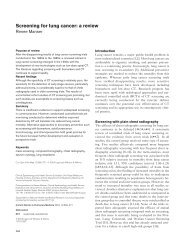
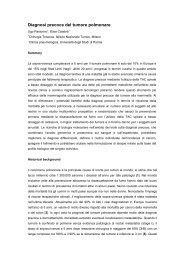

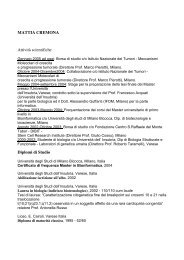


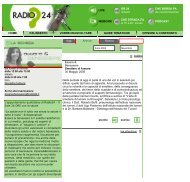
![STUDIO [18F]-FDG PET Total body](https://img.yumpu.com/18201937/1/190x135/studio-18f-fdg-pet-total-body.jpg?quality=85)
